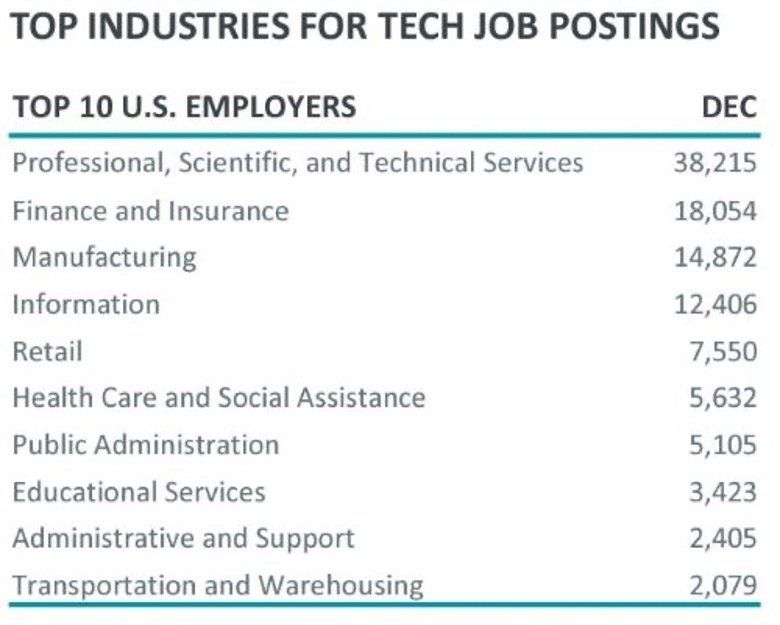Blog Layout
Why IT Is Still Great for Career Changers, Even Amid COVID-19

2021 will be a year of unprecedented career change
for millions of Americans. Last year, the economic fallout from the coronavirus pandemic was incredible, causing millions of people to lose their jobs. Those who were laid off may be forced to make a career change as quickly as possible. The last thing these individuals want is to risk losing another job as a result of selecting a career in an industry that is unstable. They may understandably be hesitant to get into an unfamiliar industry in the middle of the pandemic. But career changers who want to get into IT can breathe a sigh of relief – information technology is one of the most secure job sectors to enter at this time.
3 Reasons IT Careers Are Secure, Even During COVID-19
Changing careers is a life-altering decision that can be emotionally taxing. It's no wonder that some people put it off or ultimately choose to maintain the status quo of their work lives. Instead of being closed off to pursuing a career change during this time of uncertainty, it may be more effective to remain open to the idea of switching careers, so long as the careers you consider are economically safe choices.
Not every career is fail-proof. Even the most qualified, skilled individual can have trouble finding a job. This is true for professionals from all industries, and it can happen even when the world is pandemic-free. However, this shouldn't stop you from getting into a new field if you feel that your current profession has run its course and it's time to make a career change. Here's why an IT career is a safe career choice amid COVID-19.
1. The IT Industry Is Growing and Stable
Although the IT industry took a minor hit in 2020 regarding cutbacks, spending patterns and deferment of major investments, 2021 appears to be a promising year. The CompTIA Industry Outlook 2021
reported that if current financial trends in IT stay on track, the industry will soon return to the rate of growth that it was experiencing before the pandemic.
Also, despite the global health crisis, a great number of IT professionals were hired in late 2020. IT companies in the United States increased employment by 22,200 workers in December, and at the same time IT jobs grew by 391,000 positions, according to the CompTIA Tech Jobs Report
released on January 8, 2021.
“Another encouraging sign was a modest increase in the number of employer job postings for core information technology positions, to nearly 207,000 in December,” Esther Shein wrote in TechRepublic, citing the report.
The CompTIA Tech Jobs Report shows that the national unemployment rate in December 2020 more than doubled the unemployment rate of IT professionals. For example, the national unemployment rate in December was 6.7%, according to the U.S. Bureau of Labor Statistics, but it was just 3% for those in an IT career.
Additionally, News Break supported the idea that the IT industry is fairly stable despite the pandemic, quoting CompTIA Executive Vice President for Research and Market Intelligence Tim Herbert.
“Tech hiring continues to bring a degree of stability to a still-fragile labor market in an incomplete recovery,” Herbert told News Break. “With projections of employer demand for tech talent remaining strong in the year ahead, we hope tech can continue to serve as a catalyst for business and career opportunity.”
2. The Demand for Cybersecurity Professionals Is Strong
COVID-19 taught us a lot about cybersecurity, including how keenly aware cybercriminals are of the impact COVID-19 has had and continues to have on companies. These individuals understand that companies may be more focused on staying in business than anything else. In an effort to stay afloat, their focus may be on productivity, not cybersecurity.
Also, a great number of employees are now working remotely, which has created additional concerns with data security and opportunities for hackers. This has created a huge problem for companies and an equally large opportunity for tech specialists who have the skills to prevent and mitigate cyberattacks.
The pandemic isn’t going away anytime soon. This means the demand for cybersecurity specialists
is here to stay. And adding cloud security skills means that cybersecurity professionals can increase their salary by more than $15,000, according to Forbes. Clearly, working toward an IT career is a lucrative, secure move during the coronavirus crisis.
3. Companies Need Help Adapting to Rapid Digital Transformation
The coronavirus pandemic not only shook things up for companies regarding cybersecurity, but COVID-19 also accelerated digital transformation
in several ways. First, the pandemic necessitated remote work. As companies scrambled to make it possible for their employees to work from home, they had to rapidly adopt new technologies that facilitated remote work. Also, organizations had to make infrastructure changes, such as upgrading networks, to integrate new tech tools with their existing systems.
Accelerated digital transformation has created a sink-or-swim situation for many companies. Organizations can either adapt to the new normal of fast digital transformation or become obsolete. Moving forward, companies will need to continue making quick infrastructure changes.
IT pros with specialized knowledge of infrastructure design and maintenance will be vital to their success in effectively adopting and integrating tech tools that foster digital transformation. This is further proof that those who are interested in an IT career should feel confident making a career change in the midst of the pandemic.
Getting into IT Is Easier Than You Think
Now that you know it’s safe to get into IT at this time, there may be another barrier that prevents you from pursuing a new career: the belief that IT is a tough industry to enter. The truth is that the roadblocks for getting into the IT field are not as numerous or large as you may think. For example, you don’t necessarily need a degree in computer sciences to land your first IT job that will ultimately lead to a fulfilling career. What you do need is a foundational IT certification that proves you have the skills employers are looking for.
If you want to get into IT, especially if you have no prior experience or credentials, getting the right IT certification is a sensible place to start. CompTIA A+
is widely recognized by employers for validating the skills needed for entry-level IT jobs like help desk technician
and technical support specialist. With this foundational IT certification, you will be fully equipped to land an entry-level IT job.
Once you have your first IT certification and a bit more hands-on experience, you can earn other certifications that will provide you with in-demand IT skills that will make you a more competitive job candidate. For example, CompTIA Security+
provides key skills in cybersecurity, and CompTIA Network+
can give you the knowledge you need to help companies adapt to digital transformation.
Now more than ever, the world needs what IT pros have to offer. Because the IT industry is growing, the demand for cybersecurity professionals is strong and digital transformation is happening at warp speed, it’s safe to say that an IT career is a great choice for a new career during the COVID-19 pandemic.
Considering a career change? Take our quiz
to see if you’re ready.

By Stacy Heit
•
January 17, 2025
January 17, 2025 -- The National Association of Workforce Boards (NAWB) today announced that two members of its Board of Directors, Kathy Jewett and Debra Giordano have stepped down from their roles for personal reasons. Al Searles, a member of the board’s executive committee, has been elected to the Vice Chair position vacated by Jewett during the board’s most recent meeting. “On behalf of the NAWB team, I extend my gratitude to both Kathy and Deb for their valuable contributions and commitment during their tenure on the Board,” said President and CEO, Brad Turner-Little. “Their leadership and dedication have played an integral role in shaping our growth and I appreciate their guidance during a time of transformation for the organization.” “As Board Chair, I want to extend my deepest gratitude to Kathy for her exceptional leadership and dedication as a board director over the past six years and most recently as vice chair,” said NAWB Board Chair, Lisanne McNew. “Her vision and commitment have been pivotal in advancing NAWB’s mission and strengthening workforce boards nationwide. As Al steps into the role of Vice Chair, I am confident his expertise and passion will guide us forward, building on Kathy’s legacy and driving continued innovation and impact in workforce development.” She added, “Deb’s expertise and dedication to workforce development have been invaluable to our industry. Her thoughtful leadership and contributions have left a lasting impact on workforce boards and the communities they serve. We are deeply grateful for all she has done for our board.”

By Brad Turner-Little
•
December 3, 2024
December 3, 2024 -- NAWB President and CEO, Brad Turner-Little , made the following statement in response to the Congressional committee leadership's bipartisan, bicameral agreement to reauthorize the Workforce Innovation and Opportunity Act (WIOA). The new bill, which we provided an initial summary of, is currently being considered on a fast-track procedure in the Senate. "Since WIOA’s reauthorization in 2014, workforce development boards (WDBs) have sought to meet the evolving needs of employers, jobseekers, and the local communities that they serve. It is laudable that lawmakers have reached consensus on legislation to make significant updates to the nation’s public workforce development system, including improvements that recognize the vital role that WDBs play in strengthening local economies. Since the initial release of a new bicameral and bipartisan WIOA reauthorization agreement last week, A Stronger Workforce for America Act (ASWA), the National Association of Workforce Boards (NAWB) has spent time analyzing this proposal and engaging with our members to understand how the bill would affect ongoing operations, service delivery, and the ability of WDBs to serve jobseekers and employers alike throughout the nation. Through these discussions, it has become clear that there are aspects of this legislation that conform with NAWB’s vision for the future of the public workforce system, while there are other significant components of this agreement that will be challenging to implement at best and could undermine WBDs’ ability to meet their mission. ASWA would renew the law for five more years, sending a powerful signal that the public workforce system authorized by this legislation is critical to wider efforts in preparing and sustaining the skilled workforce needed for America’s wider success. NAWB is pleased to note that many of the organization’s recommendations have been incorporated into this legislation. These include clarifying local WDBs’ authority over local budgets; increased flexibilities to serve incumbent workers; improvements to cost-sharing requirements for one-stop centers, including flexibilities for the sharing and pooling of these resources; increased professional development opportunities for local staff; allowing for marketing and outreach efforts on behalf of the system; allowing WDBs to serve as one-stop operators when meeting certain conditions; a new emphasis on skills-based hiring; and dramatic improvements to data collection and subsequent reporting to make the public workforce system more transparent and responsive to the needs of workers and employers. While NAWB appreciates these and other aspects of the agreement, the legislation unfortunately continues to advance provisions that our organization does not support, including a new systemwide mandate for training and an overly prescriptive work experience requirement for youth funding which we believe runs counter to local autonomy and flexibility. While we appreciate the agreement’s recognition of the important role supportive services play in the success of worker skills development, we continue to call on Congress to ensure that any new requirements reflect the realities facing the populations WIOA is structured to prioritize. NAWB’s members have made clear that increased state-level set-asides will mean fewer resources will be available to local WDBs to implement these and other aspects of this legislation with fidelity. In conjunction with the proposed local workforce area redesignation provisions, NAWB’s members have also made clear that there is a strong potential that aspects of the public workforce system will need to close, staff laid off, and business services significantly curtailed under these new operating constraints. Taken together, we remain deeply concerned that these aspects of the agreement will make it more difficult for the public workforce development system to serve jobseekers and employers alike moving forward. We are grateful to have heard from so many of our members who provided thoughtful and meaningful perspectives as part of NAWB’s analysis of this legislation. They are the true experts, working every day with local community partners, elected officials, businesses, and jobseekers. We recognize the extremely challenging environment that workforce boards will be in whether this bill is enacted during the final days of the 118th Congress or if current law remains in place for the time being. In either scenario, NAWB remains committed to working closely with the incoming administration and new Congress to ensure that the public workforce development system is responsive to the needs of workers, learners, and businesses, and can fulfill the significant workforce development needs of our nation now and in the future. This will certainly be among our top priorities during Workforce Advocacy Day , scheduled for April 1-2 , 2025 in Washington, DC. NAWB members need to share their expertise with members of Congress to ensure that the workforce system has the necessary resources to serve their local communities.” Learn more about NAWB's work on WIOA.
National Association of Workforce Boards | All Rights Reserved |
Created by Olive + Ash.
Managed by Olive Street Design.






